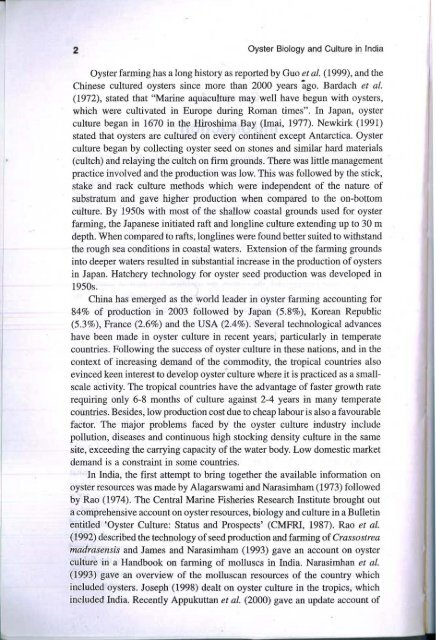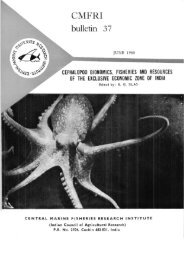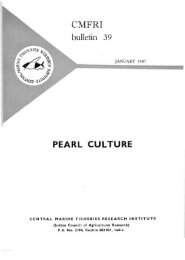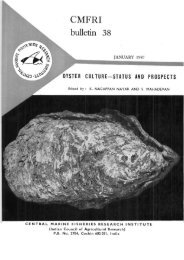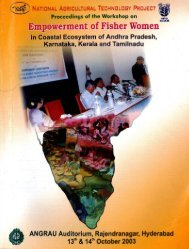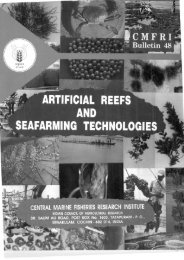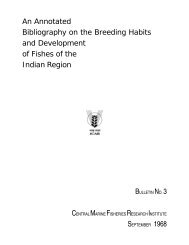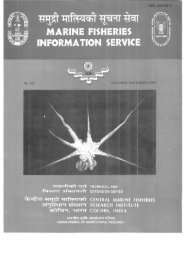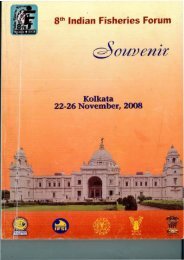y~ t',- r II 0 ( ~jY - Eprints@CMFRI - Central Marine Fisheries ...
y~ t',- r II 0 ( ~jY - Eprints@CMFRI - Central Marine Fisheries ...
y~ t',- r II 0 ( ~jY - Eprints@CMFRI - Central Marine Fisheries ...
- No tags were found...
You also want an ePaper? Increase the reach of your titles
YUMPU automatically turns print PDFs into web optimized ePapers that Google loves.
2 Oyster Biology and Culture in IndiaOyster farming has a long history as reported by Guo et at. (1999), and theChinese cultured oysters since more than 2000 years ago. Bardach et al.(1972), stated that "<strong>Marine</strong> aquaculture may well have begun with oysters,which were cultivated in Europe during Roman times". In Japan, oysterculture began in 1670 in the Hiroshima Bay (Imai, 1977). Newkirk (1991)stated that oysters are cultured on every continent except Antarctica. Oysterculture began by collecting oyster seed on stones and similar hard materials(cultch) and relaying the cultch on firm grounds. There was little managementpractice involved and the production was low. This was followed by the stick,stake and rack culture methods which were independent of the nature ofsubstratum and gave higher production when compared to the on-bottomculture. By 1950s with most of the shallow coastal grounds used for oysterfarming, the Japanese initiated raft and longline culture extending up to 30 mdepth. When compared to rafts, longlines were found better suited to withstandthe rough sea conditions in coastal waters. Extension of the farming groundsinto deeper waters resulted in substantial increase in the production of oystersin Japan. Hatchery technology for oyster seed production was developed in1950s.China has emerged as the world leader in oyster farming accounting for84% of production in 2003 followed by Japan (5.8%), Korean Republic(5.3%), France (2.6%) and the USA (2.4%). Several technological advanceshave been made in oyster culture in recent years, particularly in temperatecountries. Following the success of oyster culture in these nations, and in thecontext of increasing demand of the commodity, the tropical countries alsoevinced keen interest to develop oyster culture where it is practiced as a smallscaleactivity. The tropical countries have the advantage of faster growth raterequiring only 6-8 months of culture against 2-4 years in many temperatecountries. Besides, low production cost due to cheap labour is also a favourablefactor. The major problems faced by the oyster culture industry includepollution, diseases and continuous high stocking density culture in the samesite, exceeding the carrying capacity of the water body. Low domestic marketdemand is a constraint in some countries.In India, the first attempt to bring together the available information onoyster resources was made by Alagarswarni and Narasimham (1973) followedby Rao (1974). The <strong>Central</strong> <strong>Marine</strong> <strong>Fisheries</strong> Research Institute brought outa comprehensive account on oyster resources, biology and culture in a Bulletinentitled 'Oyster Culture: Status and Prospects' (CMFRI, 1987). Rao et al.(1992) described the technology of seed production and farming of Crassostreamadrasensis and James and Narasimham (1993) gave an account on oysterculture in a Handbook on farming of molluscs in India. Narasimhan et ai.(1993) gave an overview of the molluscan resources of the country whichincluded oysters. Joseph (1998) dealt on oyster culture in the tropics, whichincluded India. Recently Appukuttan et ai. (2000) gave an update account of


